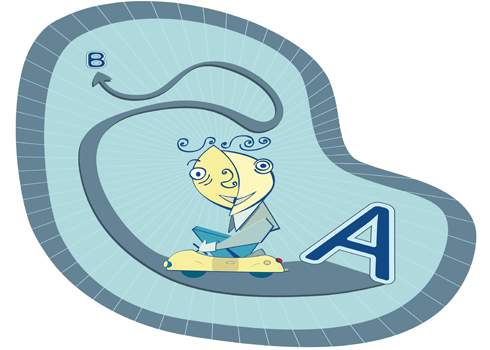The act of driving requires our full attention. I know of a woman who drove through her garage door one morning because she was on automatic pilot and didn’t notice that it was still closed! The lapse of a split second can have devastating results. How do you approach your morning drive?
Do you use the morning drive to prepare for the day to come? Is driving a placeholder, a time for fitting in extraneous activities? Do you let the frustrations of the road soak into your body and spirit, filling you with anger or draining you of energy? A one-minute mindfulness approach to driving can improve your emotional tone, stress level, and ability to be open and adaptable.
When I discuss the brain and multitasking in workshops, I often ask participants to share stories about multitasking while driving. Here are a few that stand out: eating soup, with a spoon; putting on makeup and getting dressed; reading the newspaper or a book, even on a busy freeway; simultaneously smoking a cigarette, drinking a cup of coffee, putting on mascara, and backing up the car.
Ample evidence shows that the brain does not multitask very well. A recent study showed that simply talking while driving can negatively impact our driving skills. Researchers also found the reverse to be true: driving reduces a driver’s ability to recall a conversation by as much as 20 percent. According to psycholinguist Gary Dell, one of the study’s researchers, “You might think that talking is an easy thing to do and that comprehending language is easy. But it’s not. Speech production and speech comprehension are attention-demanding activities, and so they…compete with other tasks that require your attention—like driving.” In other words, something will suffer if we decide to split our attention when we’re behind the wheel.
Basically, there are two ways to drive. The first is to drive in order to get where we’re going. Driving then is a means to an end, an act that has little intrinsic value. In this case, we may be preoccupied with other things when we get in the car. Our minds may wander off to the future. Maybe we’re engaged in a conversation with someone, literally or mentally, as we pull into the street. Our attention might be focused on listening to a radio station or thoughts about an upcoming task. I’m not suggesting that we avoid all sources of sensory input while driving but that we practice sixty-second intervals of awareness to notice when we are driving mindlessly, with our bodies going through the motions.
Fortunately, there’s a second way to go about this: drive with the sole purpose of driving. It’s that simple and direct. It’s about full participation in what we are doing with the next sixty seconds, before we even climb into the car and turn on the ignition. For example, what details do you notice about your vehicle’s door handle as you open the door? Its temperature, shape, the feel of it? How does your body bend and move as you climb into the driver’s seat? Feel your hands as they grip the steering wheel. Notice the sound of the pavement as the tires move along the road’s surface.
When we bring awareness to the next minute, we gain traction instead of dis-traction with our surroundings, from road signs and road conditions to bicyclists and pedestrians. We can also find gratitude each time we drive somewhere. Fully participating in the journey of moving from one place to another leaves no time for anxiety about the future. Driving in order to drive requires our presence in each moment—and that sets our consciousness to sixty-second time.
PRACTICE:
In the next day or week, take one driving trip where you are focused only on your driving, with no distractions. Do this when you are alone, and try to be as present as you can every sixty seconds. You don’t have to be perfect when doing this. When your mind wanders, to the past or the future, gently bring it back. You can even mentally affirm your present moment intention with the words “driving, driving.”






